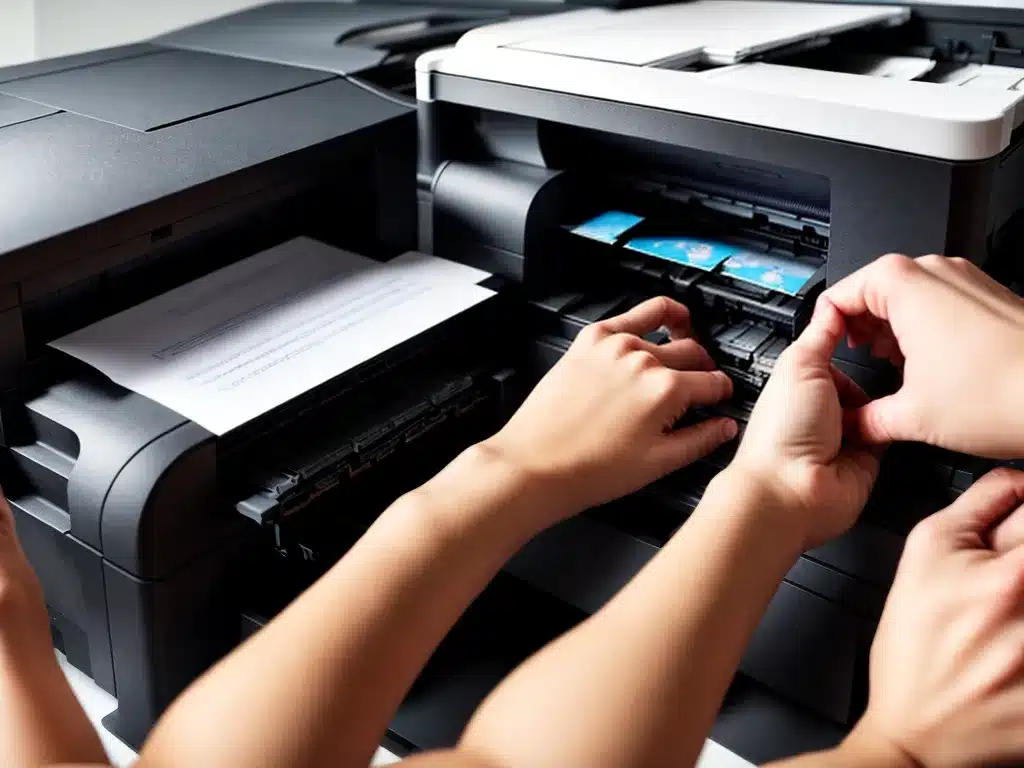
Troubleshooting Common Printer Problems
Introduction
Printers are invaluable tools that allow us to print documents, photos, and more from the comfort of our homes and offices. However, like any machine, printers can encounter problems from time to time that prevent us from printing. In this article, I will provide an in-depth overview on troubleshooting the most common printer problems users face, with actionable tips to get your printer working again quickly.
Paper Jams
Paper jams are one of the most frequent issues with printers. They occur when the paper gets stuck in the printer. There are a few things I can try to fix paper jams:
Inspect Paper Path
- Open up the printer and inspect where sheets of paper move through. Look for any jammed paper or obstructions.
- Gently remove any jammed paper. Don’t force it or you may damage the printer.
- Use a flashlight to illuminate the entire paper path and look for torn fragments of paper that may be stuck.
Check Paper Guides
- Make sure the paper guides are properly positioned and not too tight or too loose against the paper stack.
- Guides that are too tight can cause the paper to get jammed.
Use Recommended Paper
- Refer to the printer’s manual and use the recommended paper type and weight.
- Using thicker or stronger paper than recommended can cause jams.
Clean Paper Rollers
- Over time, paper rollers can accumulate dust and debris causing friction and jams.
- Clean the rollers with a lint-free cloth and rubbing alcohol.
Printer Not Recognizing Cartridges
Many printers will not work if they don’t recognize the installed ink cartridges. Here is how I can troubleshoot cartridge recognition issues:
Reseat Cartridges
- Open the printer and remove the cartridges.
- Examine the cartridges for any damage or clogs on the printhead.
- Reinsert the cartridges firmly and listen for a click.
Clean Cartridge Contacts
- Use a cotton pad and rubbing alcohol to gently clean the electrical contacts on the cartridges and the printer.
- This removes any buildup preventing connection.
Update Printer Firmware
- Access the printer menu to check for any available firmware updates from the manufacturer.
- Install the updates which may contain cartridge recognition improvements.
Replace Old Cartridges
- Ink cartridges can degrade over time. Replace old cartridges that may no longer be functional.
- Only use original cartridges recommended by the printer manufacturer.
Printer Not Connecting to Computer
There are a few reasons why printers fail to connect with computers and devices over WiFi or USB. Here is how I diagnose connection issues:
Update Printer Drivers
- Access the printer menu and update to the latest printer driver software and firmware.
- Also check for driver updates on the device you are printing from.
Reset Printer to Factory Settings
- Reset the printer by accessing the menu and restoring factory defaults.
- This clears any configuration issues preventing connection.
Change Connection Type
- If the printer connects over WiFi, try switching to a wired USB connection which is more reliable. Or vice versa.
- Try connecting to a different network if the WiFi has issues.
Replace Cables and Ports
- Faulty cables and ports can break the connection. Swap out USB cables and change ports.
- For WiFi, reposition the router closer to the printer and reduce interference.
Printer Offline
Printers set themselves offline when errors are detected. Here is how I can troubleshoot and fix offline printers:
Check for Jammed Paper
- Clear any jammed paper from the printer. Once removed, the printer will take itself offline.
Close and Reopen Printer Lid
- If the printer has a lid, close and reopen it. This resets the printer components allowing it go back online.
Check Ink Levels
- Examine ink cartridge levels. Replace empty cartridges. Printers go offline when ink runs out to prevent damaged printheads.
Restart Computer and Printer
- Shut down and restart your computer to clear any connectivity issues. Also turn the printer off and on again.
Reset Printer to Factory Settings
- If errors persist, reset the printer to factory defaults which often resolves offline printer problems.
Poor Print Quality
There are many possible causes of poor print quality such as faded text, blurred graphics, streaks, and more. Here is how I diagnose print quality issues:
Examine Printer Heads
- Open the printer and check the print heads for any clogging or dried ink. Clean heads if needed.
Clean Cartridge Nozzles
- Remove cartridges and gently clean any clogged nozzles with damp cotton swabs. Do not use any chemicals.
Calibrate Printer
- Access the printer menu and run print head alignment and calibration utilities to optimize print quality.
Use High Quality Paper
- Switch to using higher grade printer paper designed for crisp sharp printing. Avoid cheap thin paper.
Update Printer Software
- Check for driver and firmware updates which may improve print quality, optimize ink use, and more.
Conclusion
Troubleshooting common printer issues such as paper jams, cartridge errors, connectivity problems, and poor print quality can seem daunting. However, by methodically going through solutions such as inspecting paper paths, cleaning components, changing cables, and updating software, I can get my printer working again quickly. With proper maintenance and care, many printer problems can be prevented or minimized as well.












